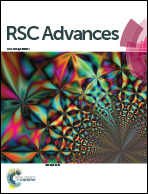Preparation of boron-doped mesoporous carbon with aromatic compounds as expanding agents
Abstract
Boron-doped ordered mesoporous carbon (B-OMC) was synthesized using the aromatic compounds benzene, 1,3,5-trimethylbenzene, 1,3,5-triethylbenzene and 1,3,5-triisopropylbenzene as expanding agents. The expanding mechanism as well as the effect of the expanding agent molecule on the properties of B-OMCs were studied. Compared with the unmodified one, the order of B-OMCs treated with aromatic compounds is improved significantly. In addition, along with the increase in hydrophobicity and steric hindrance of the expanding agents, the pore size and pore volume of B-OMCs increase, while their surface area and specific capacitance increase first, and then drop off slightly. The obtained B-OMC-TEB has a high boron content (1.54 wt%), the largest surface area (693 m2 g−1), a much better electrochemical performance and the highest specific capacitance (290 F g−1), 30% higher than that of ordinary B-OMC. Furthermore, the specific capacitance can be maintained at 155 F g−1 even at a high current density of 20 A g−1, indicating that it has a high capacitance retention rate.



 Please wait while we load your content...
Please wait while we load your content...